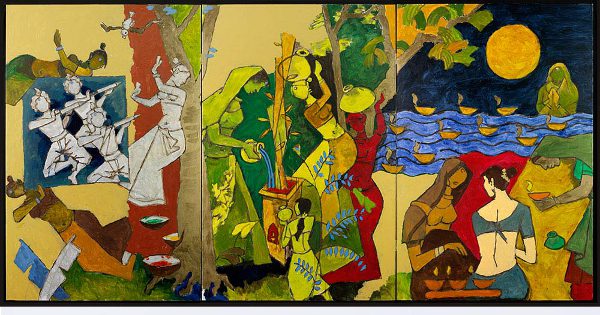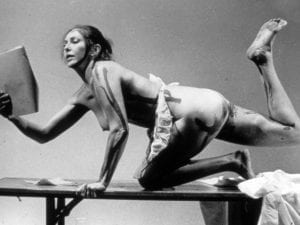It was in 1964 that the first USA exhibition of Maqbool Fida Husain (b. 1915- d. 2011), aka M.F. Husain, was displayed in India House, New York. 50 years on, we now have the opportunity to view his Indian Civilisation series at the Victoria & Albert Museum (V&A), London.
The exhibition M.F Husain: Master of Modern Indian Painting, on display until 27 July, comprises eight triptych paintings commissioned by Mrs Usha Mittal (who serves as a Member of European Advisory Board at Christie’s Inc.) in 2008, three years before Husain died. The series, originally envisaged as a 96 panel masterpiece, was cut short by Husain’s death at the age of 95.
Each of the triptychs on display explores a different theme, and in unity they create Husain’s personal vision of India which he referred to as “a museum without walls.” Displayed on platforms erected against royal purple walls and sheltered under a warm mustard-yellow ceiling, the works are exhibited in a narrow hall curated in a way that brings out the rich colour palette of Husain.
Husain, who was primarily a self-taught artist and film director, was born into a Muslim family in the city of Pandarhpur, Maharashtra, India. In his early career Husain painted cinema posters in Mumbai and worked for a toy company designing and building toys to support his income. In the 1940s Husain was one of the members of the Bombay Progressive Artists’ Group founded by Francis Newton Souza to break the nationalist traditions established by the Bengal School of Art.
In 1952 Husain’s first solo exhibit was displayed in Zurich, Austria. In 1967, Husain made his first short film Through the Eyes of a Painter subtitled, No Story: Impressions of M.F. Husain as he passes through. This unique black and white film, which won the Golden Bear Short Film Award at the 1967 Berlin Film Festival is also shown at the V&A exhibition. Husain unites sound and image the way a painter would create a painting through his quiet but sonorous brushstrokes.
The period stretching from the 1990s to 2005, can be considered as the troublesome years of Husain due to the campaign of protest brought against him by Hindu nationalist groups who accused him of disrespecting their religious beliefs through his treatment of Hindu gods and goddesses as visual stimuli rather than deities who should be held up high and respected.
In 1998, Husain’s house was attacked by the Bajrang Dal, a militant Hindu organisation, who vandalised his works. The disorder surrounding the artist rose to such a level that, due to protests, a London exhibition comprising of his work was closed. Later, Husain was faced with death threats and court cases. Living in self-imposed exile from 2006 until his death, he spent most of the year in Doha and his summers in London.
The reason why it is essential to provide a short biography of the artist is because when one steps foot into an exhibition of Husain’s art, he should have a bit of background knowledge about the artist in order to be able to comprehend the subjects and to put them into context. The V&A has not published a special exhibition catalogue that accompanies this exhibition; a short guide provides information about the works, though not so much about the artist’s life.
The triptych titled Language of Stone is inspired by the words of Bengali polymath Rabindranath Tagore who said, “How the language of stone surpasses the languages of man.” This quote hovers above the figures in the painting like an epitaph and pays tribute to India’s vast sculptural heritage. Through the distinctive visual imagery created by Husain, stone comes to life through colour, shade and subject.
Another triptych titled Indian Households, connotes the lives of three different families from three different religious faiths; Muslim, Hindu and Sikh. Regarding this triptych Husain wrote, “The interiors of 3 Indian urban households tell a true story of our common people.” In the Muslim household the grandfather is with his back to us smoking a hookah while his daughter-in-law is on her knees on a prayer rug with a rehal presumably housing a Quran.
His granddaughter is sat on a charpoy with a raw green mango on her lap. His grandson is sketching the horse figure on the floor. In the Hindu household, Husain depicts “Natraj”, the household deity, in a circle. The patriarchal head of the family, the father, is reading his morning paper while his daughter reclines on the floor reading a book.
His son is about to leave for school as his wife extends an umbrella to her son. A toddler seeking her attention is on her lap. In the Sikh household, quoting directly from Husain’s hand writing in the guide, “a hard working truck driver is proud to see his son Bittu in Fanji uniform, as the calendar poster of Gura Govind Singh is posted on the wall.” His wife is sowing on a Singer machine and his daughter is in “perfect posture of Punjab di Kudi.”
The alarm clock in the background points to midday and the events waiting to unravel. The three panels of the painting continue from one to the other seamlessly as if the families are all in one room. This evokes the peaceful feeling that we are united under one roof, the earth and also under a single God (which in effect is intrinsically a Muslim belief) regardless of our respective religious beliefs.
The piercing reds of the Hindu Triad explains the creation of the world through Hindu deities; Brahma (the creator), Vishnu (the preserver) and Mahesh (the destroyer, otherwise known as Shiva). In the guide Husain’s handwriting can be read: “The creator Brahma who visualised the concept of Universe. And with a bang it appeared physically in the infinite space. Then arrives, Vishnu to protect and preserve. Nature is in constant change. And the great forcer to restructure the Universe, a giant destroyer the Mahesh appears; who could control the world breaking into pieces…” The poetic visual language Husain utilised in this triptych is truly overwhelming; one has to view it to appreciate it.
A unifying sense of existence is seen in most of Husain’s triptychs, even when they involve opposing ideologies, schools of thought and paradoxical memories. Husain was a painter of tumultuous times and a man of silent integrity, one who wove together religious and symbolic iconography with historic figures and events as well as Indian traditions.
Hande Eagle
M.F. Husain: Master of Modern Indian Painting, V&A, London, until 27 July. For more information visit www.vam.ac.uk.
Credits
1. M.F. Husain, Traditional Indian Festivals, 2008-2011. Courtesy of Usha Mittal, © Victoria and Albert Museum, London.
Follow us on Twitter @AestheticaMag for the latest news in contemporary art and culture.




